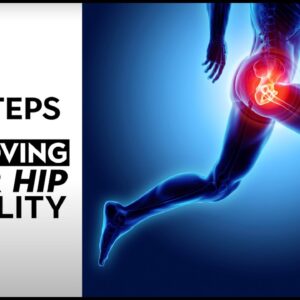In this article, we will be discussing four effective steps to enhance your hip mobility. Whether you are an athlete looking to improve your performance or someone struggling with hip pain, these steps can help you achieve greater flexibility and movement. By following these proven methods, you can unlock the full potential of your hips and improve your overall quality of life. So, let’s dive into these four steps and start improving your hip mobility today!
How to Boost Your Hip Mobility in 4 Proven Steps
Introduction
Hip mobility is critical for a smooth, pain-free movement. Whether you are an athlete, a fitness enthusiast, or an office worker, maintaining proper hip mobility plays a vital role in preventing injuries and ensuring efficient performance. In this article, we will discuss how you can boost your hip mobility in four proven steps. These steps are designed to be beginner-friendly and can be followed by anyone who wants to improve their hip mobility.
Step 1: Warm-Up and Stretching
The first step to improving your hip mobility is to warm up your muscles and stretch them. A five-minute warm-up routine that includes jogging in place, jumping jacks, or air squats can help prepare your muscles for mobility exercises. After warming up, you can perform a series of hip stretches such as the pigeon pose, butterfly stretch, or hip flexor stretch. These stretches will help loosen up tight muscles and increase blood flow to the hip area, thus making it easier to perform hip mobility exercises.
Step 2: Foam Rolling
Foam rolling is a self-myofascial release technique that helps relieve muscle tension and soreness. By using a foam roller, you can target tight muscles in the hip area and release the knots and adhesions in the muscle tissue. This will help improve the range of motion in your hips and reduce the risk of injury. Foam rolling is simple and can be performed at home or at the gym.
Step 3: Strengthening Exercises
Strengthening exercises are crucial for improving hip mobility. By strengthening the muscles in your hip area, you can stabilize your pelvis and improve your balance and posture. Some effective hip strengthening exercises include lateral band walks, glute bridges, and clamshells. These exercises can be performed using just your body weight or with resistance bands, depending on your fitness level.
Step 4: Incorporate Dynamic Movements
Dynamic movements are movements that involve multiple joints and muscles and require coordination and balance. By incorporating dynamic movements, you can improve your hip mobility and functional movement patterns. Some examples of dynamic movements that improve hip mobility include lunges, squats, and step-ups. These exercises are excellent for working the muscles in your hips, glutes, and thighs and improving overall mobility.
Conclusion
Improving hip mobility is a gradual process that requires consistency, patience, and dedication. By following the four proven steps mentioned above, you can improve your hip mobility and prevent injuries. Remember to warm up and stretch before exercising, use foam rolling to release muscle tension, perform strengthening exercises to stabilize your pelvis, and incorporate dynamic movements to improve overall mobility. With time and effort, you can achieve better hip mobility and enjoy smoother, pain-free movements.
FAQs
- How often should I perform hip mobility exercises?
Ans: It depends on your fitness level and goals. If you are a beginner, twice a week is a good place to start. However, if you are more advanced, you can perform hip mobility exercises three to four times a week. - Can I perform hip mobility exercises at home?
Ans: Yes, most hip mobility exercises can be performed at home with minimal equipment. However, it is recommended to consult with a trainer or a physiotherapist to ensure proper form and technique. - Is foam rolling painful?
Ans: Foam rolling can be uncomfortable, especially if you have tight muscles or knots. However, it should not be painful. If you experience sharp or intense pain, stop immediately and consult a professional. - How long does it take to see results in hip mobility?
Ans: It depends on your current level of mobility and dedication to the exercises. With consistent effort, you can expect to see improvement in 4-6 weeks. - Can improving hip mobility help with lower back pain?
Ans: Yes, improving hip mobility can help alleviate lower back pain by reducing the strain on the lower back muscles and distributing the load more evenly across the hip and glute muscles.
